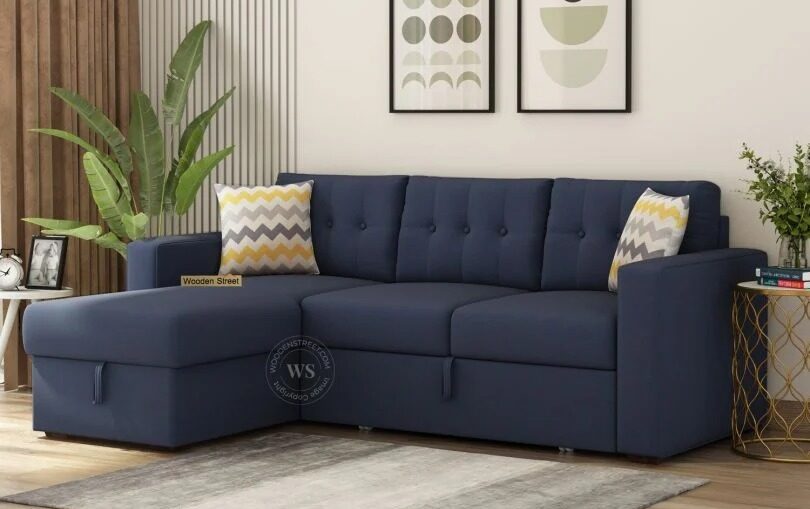A sofa is more than just a place to sit — it’s the heart of your living room, a hub for family gatherings, movie nights, unexpected naps, and late-night conversations. With all the wear and tear it endures, it’s natural to wonder: How long does a sofa really last? And more importantly, how do you know when it’s time to replace it?
Understanding the lifespan of a sofa and the factors that influence it can help you make better decisions, whether you’re buying a new one or deciding whether to hold on to your current piece a bit longer.
Average Sofa Lifespan: How Long Should It Last?
On average, a well-made sofa lasts anywhere between 7 to 15 years. The wide range exists because a sofa’s longevity depends on several key factors:
- Material quality
- Frame construction
- Usage frequency
- Maintenance and care
- Upholstery fabric
Let’s take a closer look at each of these.
1. Frame & Build Quality
The skeleton of your sofa is its frame — and this plays a crucial role in how long it will last. Sofas made with kiln-dried hardwood frames (like oak or beech) are significantly more durable than those built with softwoods or particleboard. Metal frames also provide solid durability but can be heavier and less comfortable if not padded well.
A quality frame will resist warping, creaking, or sagging over time. If you hear your sofa groaning every time you sit, it might be a sign the internal structure is failing.
2. Cushion Quality & Support
Your sofa might still look fine from the outside, but if you’re sinking uncomfortably into the cushions or feeling the frame beneath, it may be time to consider a replacement. High-resilience foam cushions tend to last longer and maintain their shape better than low-density foam.
Sofas with spring-based support systems (like sinuous springs or eight-way hand-tied springs) generally perform better in the long term than those relying only on foam or webbing.
3. Upholstery Wear and Tear
The type of fabric or leather your sofa is upholstered with has a big impact on its appearance and durability. Fabrics like microfiber, linen blends, or performance fabrics resist stains and wear better over time. Leather, if well-maintained, can age gracefully and last over a decade.
But over time, all upholstery begins to show signs of wear — pilling, fading, fraying, or cracking. Even if the structure is intact, heavily worn upholstery can drag down the look and comfort of your room.
4. Usage Patterns
A Sofa in a family home with pets and kids will naturally wear out faster than one in a formal sitting room used only occasionally. If your sofa is used for daily lounging, overnight guests, or as a snack station, you can expect its lifespan to lean toward the lower end of the spectrum.
Frequent use puts more pressure on the frame, cushions, and fabric, causing them to deteriorate faster — especially if not cleaned or maintained regularly.
5. Maintenance & Cleaning
Proper care can add years to your sofa’s life. Regular vacuuming, occasional deep cleaning, rotating cushions, and addressing spills immediately help keep upholstery looking fresh. For leather, conditioning it every 6–12 months prevents it from drying out or cracking.
Neglected maintenance, on the other hand, accelerates wear. A dusty, sun-exposed, or stain-laden sofa will lose both its aesthetic and structural quality much faster.
When Is It Time to Replace Your Sofa?
Even the best sofas don’t last forever. Here are some clear signs it might be time to part ways with your current one:
1. Sagging or Uncomfortable Seating
If sitting on your sofa feels more like sinking into a hole or perching on a slope, the inner support system (cushions or springs) is likely compromised.
2. Noisy Frame or Loose Joints
Creaking noises, wobbly arms, or shifting backrests indicate structural issues. These not only affect comfort but could be unsafe over time.
3. Stubborn Stains and Bad Odors
If deep cleaning no longer removes smells or stains — especially from spills, pets, or smoke — the internal padding may be contaminated. That’s hard to fix and a good sign it’s time for an upgrade.
4. Outdated Style
Design trends evolve. If your sofa looks like a blast from the past and doesn’t match your current décor, replacing it can refresh your living space dramatically.
5. Allergy Triggers
Old sofas can trap dust mites, mold spores, and allergens in their fabric and padding. If you’re experiencing allergy flare-ups around your couch, replacing it might improve your indoor air quality.
Can You Extend Your Sofa’s Lifespan?
Absolutely! Here are a few tips:
- Rotate and fluff cushions regularly to prevent uneven wear.
- Avoid direct sunlight, which fades fabric and dries out leather.
- Use washable covers or throws in high-use households.
- Vacuum the upholstery at least once a week.
- Spot clean stains promptly using recommended methods.
- Reupholster instead of replace, if the frame is in good shape but the fabric is worn.
Reupholstering can be cost-effective for high-quality sofas, but if the internal springs, cushions, or frame are also worn out, a full replacement is the smarter option.
Choosing a New Sofa: What to Look For
When it is time to replace your sofa, keep these criteria in mind to ensure long-term satisfaction:
- Solid hardwood or metal frame
- High-density foam or coil cushions
- Stain-resistant or easy-to-clean fabric
- Warranty coverage for frame and fabric
- Proper size and shape to suit your room layout
Don’t forget to test it in person if possible. Sit, lounge, and lie on it. Aesthetics matter, but comfort and durability are key.
Final Thoughts
Your sofa may not have an expiration date printed on it, but being aware of its lifespan and signs of wear can help you make timely decisions. After all, a sofa should offer comfort, support, and beauty — not creaks, sags, and embarrassment.
If your couch is past its prime, investing in a high-quality replacement will refresh your living space and provide years of comfort to come.






